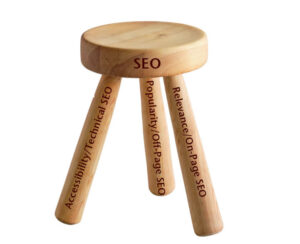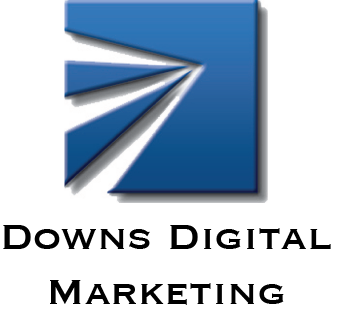SEO (Search Engine Optimization) is often described as a “Three-Legged Stool” with three pillars or components contributing to a successful SEO campaign. The three legs typically represent:

Accessibility: Accessibility is sometimes called Technical SEO by web professionals. This leg focuses on the technical aspects of a website that affect its search engine visibility. Accessibility includes factors such as website structure, site speed, mobile-friendliness, and schema markup. Search engines use schema markup to better understand the content on web pages. Its use on blogs and web pages is a great way to improve organic ranking. Accessibility ensures that search engine crawlers can effectively access, understand, and index a website’s content.
Relevance: Relevance is also called On-Page SEO. Google added relevance in the second generation of its algorithm about 20 years ago to counter early black hat SEO practices such as keyword stuffing. On-page SEO deals with optimizing individual web pages to rank higher and earn more relevant traffic in search engine results, which involves optimizing content, meta tags, headings, URL structure, internal linking, and other elements directly within the HTML of each web page. On-page SEO works to build strong relevance between web page content and its HTML meta tags.
Popularity: Popularity or Off-Page SEO involves activities that take place off the website to drive traffic to it, making it more popular. Activities include building high-quality backlinks from other authoritative websites and attracting click traffic from social media and referral network platforms. Blogging efforts add to a website’s trustworthiness, authority, and relevance. The most reputable and relevant websites in a given market attract the most search traffic, with some clicks converting into leads and additional sales.
When the Plot (Leg) Thickens

Companies operating in new or niche markets with desirable products and services get noticed quickly and start to attract organic search traffic without much effort. Most companies are not so lucky and have web-savvy rivals. In a competitive market, multiple businesses offer similar products or services, creating a crowded and often saturated marketplace—these companies are going after the same customers. They must find ways to differentiate themselves and stand out. The effort and money spent will depend on the willingness of their competitors to compete against them. In competitive web markets, content quality, visitor experience, voice of authority, conversion, and measurement matter a lot and are discussed below.
Differentiation: The main job of a website’s home page is to define a company’s business clearly. It relays the business’s elevator pitch, whether superior product quality, exceptional customer service, innovative features, or competitive pricing.
Voice of Authority and Reputation: When considering this concept, put yourself in Google’s shoes. Google’s mission is to deliver the best results from its search inquiries. A great way to inform and teach search engines about a business is to supply Google with high-quality content that will be indexed over time. The words must be well crafted and sincere and placed in blog posts, articles, videos, and infographics to resonate and build authority. Doing so creates a reputation on the web and also attracts potential customers.
Social Media Engagement: Facebook, LinkedIn, and other social media platforms can target potential customers by location, age, and other demographics. These platforms help companies engage with their followers, share valuable content, run promotions or contests, and respond promptly to inquiries to foster a community around their brand. Followers sharing on these platforms expand a business’s reach into a market. They also send clicks back to a company’s website, making it popular in the eyes of Google.
Customer Reviews and Testimonials: Many customers use referral networks like Google My Business, Angies List, and Yelp to gauge a business’s reputation before purchasing or hiring it. Companies should encourage their customers to leave positive testimonials on third-party review platforms of their choice. These reviews can significantly influence potential customers’ purchasing decisions and build trust in a company’s brand.
Keep Up With the Jones: Web-savvy companies survey their rivals’ web strategies, products, pricing, and marketing efforts monthly. They try to match or better their rivals’ web marketing efforts, capitalize on competitors’ SEO mistakes, or take advantage of business opportunities they may have overlooked. Sometimes, if they get lucky, companies improve their monthly organic ranking because of their competitors’ SEO blunders.
Measure to Improve: Companies serious about gaining more customers from the web should focus on monthly organic search traffic and web sales revenues. Organic traffic denotes web presence and popularity, and web sales reflect the effectiveness of their marketing spend. They regularly analyze their marketing efforts, website performance, and customer feedback to identify areas for improvement. They adapt their strategies based on changing market trends, competitor web marketing tactics, and customer preferences to stay competitive in the long run.

Marketing Mix: It is typical for the marketing mix at the beginning of the web effort to differ one or two years later. The social media and referral network ecosystem is dynamic. Leading players sometimes change policies and pricing or lose market share, making it less advantageous to advertise with them. If companies measure marketing ROI each month, they notice these changes early. They should keep and invest more in marketing activities that effectively bring in new customers and cull the ones that do not.
It Is Still Rock and Roll to Me: Many of the abovementioned are standard marketing practices that have been around since Waterford Crystal started placing ads in the London Times in the late 1700s. The concepts are similar, but the medium is the web, not print, radio, or TV broadcasting. What is great about web marketing is that media buy performance is measurable since everything runs on computers.

Accountability: Sometimes, marketing and digital agencies produce attractive marketing materials and develop beautiful websites, but their efforts could be more effective in generating new business for their clients. Savvy companies should measure the ROI of each activity in their marketing mix to understand performance and hold their agencies accountable for bringing in new business from the web. Doing so helps companies get the most out of the annual marketing investment.
In summary, while On-page SEO makes a website accessible and relevant, off-page SEO attempts to build authority, making the website stand out in the markets it serves. In competitive markets, the popularity leg becomes the most significant task for growing a brand and acquiring new customers. All three legs of the SEO stool are essential for a comprehensive and effective SEO strategy.
Downs Digital Marketing has been offering SEO services since 2010. We use best-in-class SEO methodologies and embrace being held accountable by our clients to generate new business from the web. Companies looking for a free assessment of their web marketing efforts should go to downsdigitalmarketing.com and fill out a request form or call us at 303-748-5851.

